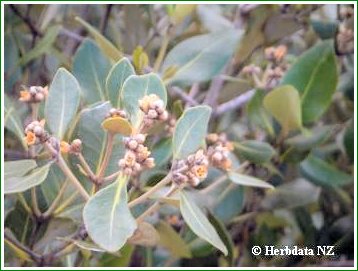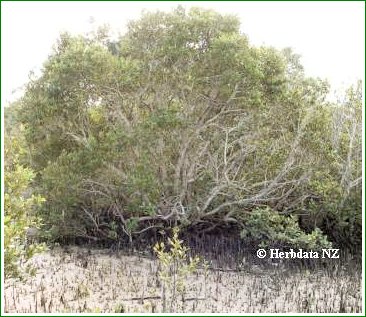

The Mangrove
Avicennia officinalis
L.
Compiled and edited
by
Ivor Hughes
Introduction:
All Members All members of the Mangrove family will be
medicinal to a lesser or greater extent. It will be noted that they grow in
salt water around inlets and estuary areas. They signal Mosquito and also
now in many areas, the dreaded Malaria. This is a generic name for a whole
host of fevers transmitted by the mosquito. The word Malaria simply means
bad air.
The mangrove is a febrifuge or fever producer when taken internally. The effect and manner of working is the same as that for Red Bark or Cinchona which is still most effective for malaria. We would all do well to remember that the now parlous state of this particular area of medical concern has been due entirely to the meddling with synthetic febrifuges and dripping hypodermic needles.
The herbalist will note that the cure for the cause of a malaise will be in close proximity to the cause. Upon this you may rely for that is in the order of things. Beware of toxic discharges into the areas in which these trees grow. That means considering the upstream ecology.
 Harvesting Bark:
Harvesting Bark:
Never take the bark from the trunk of a
tree. This is tantamount to having the skin flayed from your back and just
as life threatening. Lop a small growing branch that will likely contain the
amount of bark that you need. The branch is trimmed so that one is left with
a small pole. The pole will then need to be rossed, this simply means that
the branch is scraped clean of its surface layer leaving the inner bark
(normally red or pink or in some members white) the exposed inner bark is
then incised along its length, this is easily achieved with the blade of a
hooked linoleum knife. The scrapings are discarded and sections of inner
bark are removed in the same manner as that used for cinnamon (which see the
monograph) It becomes easy with practice,
Preparation of the Crude Drug:
Enzyme activity is not required in this case.
The prepared quills must be conveyed to a dryer as quickly as possible
(Microwave is not acceptable) Under no circumstances should the temperatures
employed exceed 60�C its moisture content must be reduced to 6% at which
point enzyme activity will cease and the crude drug may be considered
stable. Storage should be in a sealed container preferably amber glass and
kept in a cool dark place. If it has been correctly dried it will remain
viable for circa 9 months. Thereafter it will deteriorate rapidly unless
onward processed into a tincture or liquid extract which will then remain
viable for decades.
The following is extracted from Plants of New Zealand 5th Edition by Laing and Blackwell. The book is a labour of love and scholarship. If you can find a copy, it is worthy of your bookcase.
Avicennia officinalis (The Mangrove).
Leaves 2 to 3 inch long, oblong, obtuse,
leathery. Flower panicles a yellowish brown. Maori name �Manama�.
It exudes a kind of green aromatic resin which has been used as a famine
food by the Maori.
This is the mangrove of the Auckland Coast. It is to be found on all tidal flats north of Kawhia on the West, and of Opotiki on the East Coast. The species, however, is not endemic, but occurs also in Australia, throughout Melanesia and Malaysia to India, and sporadically as far North as Mount Sinai in the Red Sea. It is replaced by another species of the same genus elsewhere in the tropical world.
A further reference is made to the Mangrove in The USD 1926; Part 2.
Rhizophora Mangle L. This is a tree with
coriaceous, elliptic to elliptic ovate leaves and large yellow flowers
belonging to the Rhizophoracae and forming thickets along the coast of
Florida and in the tropics. The red bark of the mangrove tree has been used
for many years by the natives of South America as a febrifuge. Duque and
Moreno (R. M., 1905, p. 479) have claimed that it is a specific in leprosy.
They administer a beginning dose of one fluid drachm (3.75cc) of the fluid extract twice a day which is gradually increased until the patient is taking a fluid ounce and a half (45cc) daily.
Editors note:
With reference to the use of a febrifuge for
contagious leprosy. Duque and Moreno, applied the same principles that apply
for the mosquito ague. The increasing dose displays art in the
administration of the febrifuge against an invasion of the blood stream by
unwanted organisms. By increasing the dose, the induced fever was maintained
against the natural tendency for the adaptation or tolerance by the body to
medicinal substances.
Like cures like, or in homeopathic terms, Similia Similibus Curantur.
Did you find what you were looking for? If not, return to the site library
or use the search box at the top right hand of the page.
-::-
Library